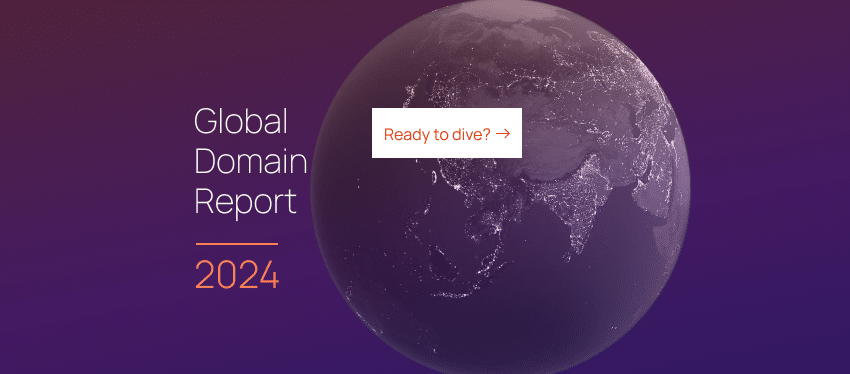
2024 | Domain industry predictions

Peek into the future with 11 predictions about what will shape the domain industry in 2024. As pioneers in the domain business, we strive to unlock possibilities and expand our horizons while closely following trends. Ready to join us?
Published by

Simone Catania
Date
The domain industry is evolving and reshaping significantly as the world increasingly immerses itself in the digital universe. From big brands through SMEs to personal projects, domains play a pivotal role in creating a distinct digital identity. With the rise of digital economies, the domain industry has become more than just an arena for obtaining a virtual address—it has transformed into a marketplace for creativity, innovation and high-stake investments.
This article provides an in-depth overview of the future of the domain industry as we enter 2024. In a world marked by constant evolution and the fast-paced emergence of new trends, making future predictions can be a somewhat daunting task. However, by studying past and current trends, incorporating expert insights and analyzing data, we aim to devise a comprehensive prediction of the industry’s trajectory in the coming years.

State of the domain industry: A retrospective
When examining the recent history of the domain industry, the last ten years clearly stand out as a pivotal era. This period was marked by significant changes and developments that substantially impacted the trajectory of this digital landscape.
A notable change was the introduction of new gTLDs and the skyrocketing growth in demand for domain names. As business moved online, the need for TLDs surged dramatically and some new gTLDs became hot trends in niche industries, like .xyz becoming a seal for Web3 companies. We also witnessed an uptick in demand for ccTLDs, with .de becoming one of the strongest TLDs worldwide and .ai gaining serious traction recently due to developments in the field of AI. Similarly, the secondary market for domains intensified, with more businesses willing to invest in premium domain names in order to achieve recognition and superior rankings quickly. This era saw some of the most significant domain sales, underscoring the high-stakes nature of the industry.
However, the defining moment of this period came with the onset of the global COVID-19 pandemic. The shift towards online business and acceptance of remote work resulted in an unparalleled digital transformation and caused a massive spike in domain registrations — particularly for cloud-based and e-commerce platforms. The necessity for businesses to not only have a digital presence but to also maintain a robust and secure online operation was a significant development that had a long-lasting effect on the domain industry.
From a broader perspective, 2013 to 2023 was a transformative era for the domain industry, punctuated by high demand, significant investments and the overarching need for comprehensive digital evolution. As we delve into predictions for the future, these developments form the foundation of our expectations for 2024.
11 domain industry predictions 2024
Let’s turn our sights to the future to shed light on what lies ahead for the domain industry in 2024. Our gaze forward examines sophisticated technological paradigms, economic impacts, renewed security discourse and shifts in domain pricing. These estimations represent the culmination of InterNetX’s expert overview of the industry as a leading B2B registrar, understanding past trends and market evolution.
These predictions are intended to be waymarkers that can aid those within the domain industry to anticipate, prepare and adapt to the manifold opportunities and challenges that 2024 might yield.
1Domain market growth and economic impact
The domain market is expected to experience further significant growth. Factors such as increasing digitalization, innovative technological applications, the new gTLD round and evolving business models will contribute to this upswing. This growth will boost the size and value of the domain industry and have multiple ripple effects across the broader economy, leveraging new business opportunities for domain resellers. Emerging markets, in particular, could capitalize on this momentum to unlock considerable economic potential.
2Changes in domain pricing
Given past trends and anticipated market dynamics, we foresee shifts in domain pricing. Contributing factors include increased competition among registries, the scarcity of memorable gTLD and leading ccTLDs domain names as well as the growing relevance of new gTLDs. Moreover, inflation, the ongoing energy crisis and geopolitical instabilities will all add fuel to these price increases. While the precise rate of fluctuation is hard to predict, the trend implies that businesses, investors and consumers must stay alert to such changes. Multi-year domain registration and partnering with experienced domain registrars could be pivotal strategies to effectively handle price changes.
3Enhanced security measures
As digital threats become more advanced and dynamic, while having increasingly far-reaching consequences, domain stakeholders and ICANN are ramping up security measures against DNS abuse. Anticipated developments include broader adoption of multi-factor authentication systems and more stringent rules for domain transfers like the Registry Lock and registrations with meaningful and transparent contractual obligations. The intent will be to safeguard registrants from cybersecurity risks and improve domain security while ensuring a seamless online experience.
4Increased AI integration
The ongoing technological revolution has given artificial intelligence (AI) and machine learning (ML) a new and dominant position in the domain landscape. Advanced algorithms can augment domain registration and management by performing tasks such as automatic renewals and predictive analytics for securing better domain names. Such technologies can also help combat cybersecurity threats, making AI and ML integration an inevitable and beneficial trend for the industry.
5New gTLD introduction
Expect to see the launch of new gTLDs over the next couple of years. Domain stakeholders are already actively participating and contributing to their development. As trends in branding are shifting and businesses are searching for unique and relevant digital identities, companies and investors are showing increased readiness to register these innovative new gTLDs. Furthermore, specific sectors might prefer industry-focused TLDs, infusing the domain landscape with fresh dynamism. Keeping abreast of these introductions, backed by proactive participation from several domain stakeholders, can yield a competitive advantage when securing the ideal domain name.
6More regulation
An increase in regulatory oversight for the domain industry and the general digital ecosystem is predicted due to escalating concerns about privacy and security. Implementing standards like the NIS2 Directive across different regions could set a new compliance norm for the industry. Businesses, domain registrars and other associated stakeholders must rethink their current policies in order to comply with evolving regulatory measures.
7Domain aftermarket growth
According to Sedo, the domain aftermarket comprising second-hand, expired, or dropped domains, is expected to continue growing. The availability of premium domains is becoming increasingly scarce. Simultaneously, more companies are interested in securing premium domains that are particularly catchy and short to differentiate themselves from competitors. This increasing demand is driving up prices in the aftermarket. In 2024, keywords that will be in high demand include those that work well with voice search, as well as words related to chatting, bots, machine learning, renewable energy, and the defense and aerospace industries.
8Aggressive marketing activities
Registrars and registries, particularly for new gTLDs, are likely to intensify marketing and branding efforts with the aim of differentiating themselves in a competitive environment. Aggressive marketing and unique selling propositions could emerge as decisive factors to stand out in a market packed with similar offerings. Paying attention to these strategies allows businesses to capitalize on the potential benefits of these TLDs and engage domain stakeholders.
9Domain privacy services growth
Given the escalating concerns about privacy, the demand for domain privacy services—anonymizing the identity of domain registrants—is predicted to rise. Services like Whois Privacy can protect domain owners from unwanted attention or potential threats. Evaluating the provisions of domain privacy services will become an essential element of domain registration and management.
10Consolidation trend
The market is currently experiencing a consolidation trend, highlighting the domain industry’s dynamic nature. Smaller domain registries and registrars are joining forces. InterNetX, for example, is now part of the IONOS Group, with the aim of becoming Europe’s leading SMB digitalization partner and trusted cloud enabler. This wave of consolidation could influence the competitive landscape, pricing dynamics and the diversity of services offered. By staying abreast of these changes, businesses and investors can make well-informed decisions.
11Green domains
The dynamic shift towards environmental consciousness is evident in all industries. It has become increasingly necessary for domain operators to showcase such a commitment. We might witness the advent of green domains in sync with the accelerating focus on sustainability, acting as a digital badge of honor. Adopting these domains may give businesses an edge in building a green reputation and resonating with eco-conscious customers and partners.
Preparing for the future of the domain industry in 2024
As we enter 2024, the domain industry is poised to undergo significant change. This sector’s trajectory presents exciting developments due to ongoing digitalization and innovation. In the light of these predictions, it is evident that the domain industry is on a transformative path leading to a world of opportunities and challenges. Businesses, investors and consumers will have to adapt to these trends in order to ensure effective domain registration and management in the digital age.






